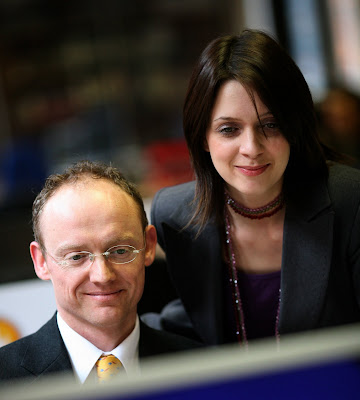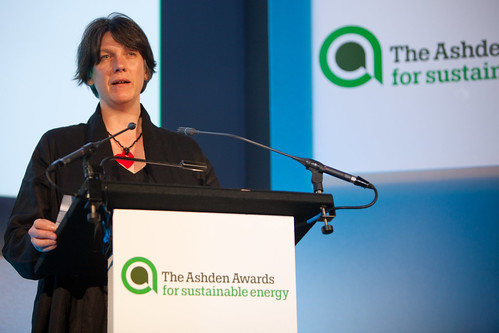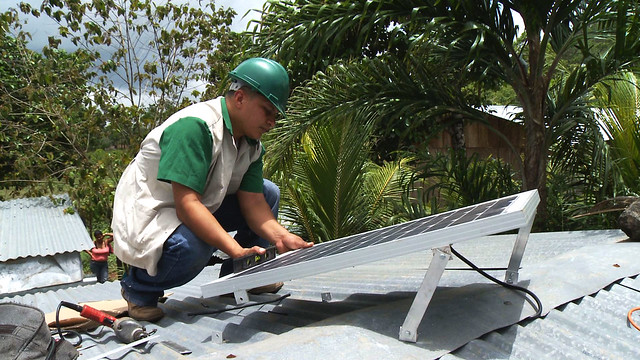 2010 Ashden Gold Award winners d.light design has been shortlisted for the prestigious FT ArcelorMittal "Boldness in Business" Awards. From an initial list of 250 nominations, d.light has been selected as finalists in the "Newcomer" category along with five other organizations, including Groupon, MetroBank and Zynga. Last year's winner in this category was Twitter.
2010 Ashden Gold Award winners d.light design has been shortlisted for the prestigious FT ArcelorMittal "Boldness in Business" Awards. From an initial list of 250 nominations, d.light has been selected as finalists in the "Newcomer" category along with five other organizations, including Groupon, MetroBank and Zynga. Last year's winner in this category was Twitter.
The "Boldness in Business" Award was established by the Financial Times and ArcelorMittal to highlight and celebrate companies and entrepreneurs who are innovative and dynamic. The award winners will be announced at a ceremony in London in March 2011.
Monday 31 January 2011
d.light design shortlisted for Financial Times ArcelorMittal "Boldness in Business" Award
Friday 28 January 2011
Government warns UK firms to make better use of resources
 A major report, published by DEFRA, explains the need for UK firms to factor resource issues into their long-term decision-making and to find alternatives to the materials they now use. We recently highlighted that one of our past winners, ENWORKS, is helping businesses do just that.
A major report, published by DEFRA, explains the need for UK firms to factor resource issues into their long-term decision-making and to find alternatives to the materials they now use. We recently highlighted that one of our past winners, ENWORKS, is helping businesses do just that.
Business Green reports:
“According to the research ... a wide range of materials will face constricting supplies over the next few decades as the global population rises towards an estimated nine billion by 2050. [T]he report warns that the supply of rare earth elements is likely to be particularly constricted. Companies will have to increase recycling rates and make better use of metals such as indium (a component in solar panels), as well as cobalt and lithium (elements in electric car batteries and solar cells).”
Todd Holden, ENWORKS director, says small and medium-sized enterprises (SMEs) are often aware of the importance of resource efficiency, but this doesn’t often translate into action:
"Our own independent research on business attitudes, which surveyed businesses of all sizes, but focused on SMEs, has found that 82% of businesses felt that resource efficiency was 'very important' or 'of some importance' to them. Yet, crucially, only 33% had made efficiency improvements in their use of energy, materials or water in the previous 12 months, and only 20% were planning to do something about it in the following 12 months.”
It's clear more could be done. The financial savings alone make this self-evident. DEFRA’s report states that energy efficiency measures could save British companies more than £6bn a year.
See also: ENWORKS shows that resource efficiency can save your business
Thursday 27 January 2011
If you missed IEA's chief economist "saying the unsayable", slides from the talk are now online
Last week we blogged that Fatih Birol, chief economist at the International Energy Agency, had said the unsayable: that is, it's virtually impossible for us to meet climate change targets with current policies.
Dr Birol made these remarks at a lecture at the Grantham Institute for Climate Change. The slides from that lecture are now online. The concluding slide states:
Recently announced policies can make a difference, but fall well short of what is needed for a secure & sustainable energy future
The age of cheap oil is over, though policy action could bring lower international prices than would otherwise be the case
Stronger penetration of natural gas can have profound implications for energy markets and environment
Renewables are entering the mainstream, but long-term support is needed to boost their competitiveness
Lack of ambition in Copenhagen/Cancun has increased the cost of achieving the 2C goal & made it less likely to happen
Wednesday 26 January 2011
South Korean officials spend this morning studying Suffolk County Council’s approach to woodland management
 (photo from left to right: Gary Battell, Simon Brammer, Andrew Rowe, Elvin Ozensoy, Councillor Jane Storey and Dr Kim)
(photo from left to right: Gary Battell, Simon Brammer, Andrew Rowe, Elvin Ozensoy, Councillor Jane Storey and Dr Kim)
A number of government officials from South Korea today visited Suffolk County Council as part of their research and development strategy in a move towards becoming a low-carbon economy. Last year Suffolk County Council won an Ashden Award for its outstanding work in supporting the local wood-fuel supply chain and installing wood-fired boilers in schools.
Simon Brammer, our UK programme manager, joined Dr Kim, from the Rural Development Administration of South Korea, Councillor Jane Storey, Suffolk Council’s Deputy Leader, and Andrew Rowe and Gary Battell, who were responsible for delivering the award winning project. Simon reports:
“South Korea recently announced a plan to spend £22.6m over the next five years to develop renewable energy sources and to accelerate the transition to a low-carbon economy. The latest investment is part of the government's green growth strategy, aimed at turning environmental technologies into the main drivers of economic growth and new sources of jobs. The investment programme is also designed to reduce the country's heavy dependence on oil and gas imports and tackle greenhouse gas emissions.”
“South Korea has significant woodland which they hope to manage in the innovative way that Suffolk has done by establishing strong supply chains and resurrecting the art of woodland management”.
“It is very exciting to see our UK winners supporting the efforts that other countries, from right across the globe, are making in their transition to a sustainable energy economy.”
To feed eight billion people in 2030, we need to remember our food system is linked to our energy use
 Three reports have appeared in the last fortnight highlighting the urgent need to address the food, energy and water demands of a population that's expected to reach eight billion by 2030. The report, One Planet, Too Many People?, from the Institute of Mechanical Engineers, looks at the pressures of population growth on our food, energy and water systems. The report, State of the World 2011: Innovations that Nourish the Planet, from the World Watch Institute, explores sustainable solutions to our food system. The Foresight Project's Global Food and Farming Futures report examines how we can meet the food needs of our planet in the next 20-40 years.
Three reports have appeared in the last fortnight highlighting the urgent need to address the food, energy and water demands of a population that's expected to reach eight billion by 2030. The report, One Planet, Too Many People?, from the Institute of Mechanical Engineers, looks at the pressures of population growth on our food, energy and water systems. The report, State of the World 2011: Innovations that Nourish the Planet, from the World Watch Institute, explores sustainable solutions to our food system. The Foresight Project's Global Food and Farming Futures report examines how we can meet the food needs of our planet in the next 20-40 years.
Mike Pepler, our UK Awards Manager, emphasises the theme that's emerging from each of these studies: the challenge of how to feed the world in 20 years' time must be done in combination with meeting rapidly rising energy demands. We must address our need for a productive food system at the same time as reducing our dependence on fossil fuels.
A good example of the energy input that goes into agriculture is fertilisers. Our intensive use of fertilisers produces a double whammy of greenhouse gases. Mike says:
"Nitrogen is a key element needed for plants to grow, but it has to be incorporated in chemicals that plants can use. There are natural processes that achieve this, but the nitrogen added through man-made fertilisers has doubled the amount available for plants to grow. CO2 is released as a result of the Haber-Bosch process which is used to produce ammonia to make fertiliser. Then the fertiliser, once spread on the field, also emits nitrous oxide - this is the third most significant greenhouse gas, after CO2 and methane."
"About 3-5% of the world's natural gas supply is used to produce nitrogen-based fertiliser - that is about 1-2% of all energy use globally. Although the advent of petro-based chemical fertilisers in agriculture is one of the pillars of the 'Green Revolution' that boosted food production in the latter half of the twentieth century, it has come at the cost of increased greenhouse gas emissions".
"The climate change caused by greenhouse gases, including those emitted by fertilisers, is now threatening food production, and will become more of a problem as time goes on. We must recognise the link between sustainable energy systems and our agricultural system. More research is needed on this topic."
See also: Three steps that each of us can take to help.
(Pic: Farmer in Vietnam uses slurry from biogas production as a natural fertilizer for their crops)
Tuesday 25 January 2011
In current financial climate, ENWORKS shows that resource efficiency can save your business
 Juliet Heller speaks to Samantha Nicholson, Operations Manager of ENWORKS about its successful Online Resource Efficiency Toolkit, which helps businesses across the North West to make cost savings. In the current financial climate, it couldn't be more useful.
Juliet Heller speaks to Samantha Nicholson, Operations Manager of ENWORKS about its successful Online Resource Efficiency Toolkit, which helps businesses across the North West to make cost savings. In the current financial climate, it couldn't be more useful.
ENWORKS won an Ashden Award four years ago for demonstrating that good environmental practice in businesses is profitable. Since then, their business support has gone from strength to strength. The support that ENWORKS provides has helped businesses in the North West save over 669,000 tonnes of CO2 a year, and generated savings of over £120 million a year. Since the Toolkit was launched in 2004, it has supported over 8,700 businesses of all sizes, in the North West and further afield.
The Toolkit is part of ENWORKS' wider resource efficiency programme. Samantha explains:
“We immediately remove a lot of the barriers to businesses that haven’t embarked on the sustainability journey so far. This isn’t a report or manual that sits on a shelf gathering dust, it’s an easy to use electronic tool that allows busy staff to manage large amounts of detailed data across several projects, and it’s continually updated to align with the latest national research on CO2 calculations."
"The toolkit also helps managers who are facing resistance to adopting environmental measures to build a stronger internal business case. The data provides them with the pros and cons of specific measures, both in a financial and environmental sense.”
There could be a growing demand for this approach in the UK. A recent Carbon Trust survey of finance directors found that big businesses wastes £1.6 billion a year on energy that could be saved through easy measures, such as upgrading heating and lighting, and carrying out staff training in energy saving. The research found that energy efficiency projects could deliver an average return on investment of 48%. The average payback period on large-scale business investments in energy efficiency is only three years, the report says, but many straightforward improvements cost little or nothing at all. Over half of the cost savings, that ENWORKS helps implement, are made at no capital cost. Samantha adds:
“We are working with an amazingly diverse range of businesses including manufacturers, haulage companies, hotels and leisure centres and healthcare organisations, just to give a flavour. We have enough data now to demonstrate clearly that the Toolkit is helping businesses make huge savings and we are happy to share our knowledge and expertise with others, for example through tools such as our ENWORKS In a Box site. We hope more and more businesses will recognise the value and economic sense of increasing their resource efficiency”.
In the current financial climate, the efficient use of resources such as energy, water and materials can make the difference between losing or saving your business.
(pic: Samantha Nicholson with ENWORKS director Todd Holden)
Monday 24 January 2011
Sir John Beddington warns of world food crisis. Here's three steps you can take to help
This morning the Government's chief scientific adviser Sir John Beddington discussed the threat of a world food crisis. A billion people today are hungry. The population is rising rapidly. A new report says that farmers, politicians, economists and scientists need to think how to make food production more efficient and deal with the problems of water and energy.
Our UK awards manager, Mike Pepler, says there are three steps that each of us could take to help.
Don’t waste food. Food that is thrown away has not just wasted the food, but everything that went into producing it, including water, fertiliser, pesticides, diesel (for farm machinery and transporting it), electricity (for refrigeration), packaging and also the energy you use at home to refrigerate and cook it.
Eat less meat. Producing meat requires much greater input of fossil fuels than producing other food, and has a corresponding higher emission of greenhouse gases. It also takes up more land area, as animals are often fed crops that could have been eaten by people, so the more meat we eat, the less food is available in total.
Grow your own. Growing a bit of food at home can be quite easy, and you have the option to do it organically by avoiding any use of chemicals. You’ll also have no food miles, as it only has to travel a few steps to your kitchen.
Ashden judges pick this year's shortlist
 The Ashden Awards judges have just announced the shortlist of 32 projects for the 2011 Ashden Awards.
The Ashden Awards judges have just announced the shortlist of 32 projects for the 2011 Ashden Awards.
This year's international applicants, ranging from Africa, Asia and Latin America, use innovative approaches to tackle poverty and climate change, including creating fuel pellets from waste biomass, solar LED lanterns and small wind turbines.
The UK applicants are spread across the country, from Brighton and Devon to Scotland and Lancashire. These ground-breaking initiatives range from an enterprise using biodiesel for community transport to programmes retrofitting homes and community groups that promote behaviour change.
Take a look at our news page for more details on the projects that tackle poverty and climate change.
Sunday 23 January 2011
Pace of transition to cleanstoves "worryingly slow"
Today's Independent on Sunday carries the headline: Home fires: The world's most lethal pollution.
The world's deadliest pollution does not come from factories billowing smoke, industries tainting water supplies or chemicals seeping into farm land. It comes from within people's own homes. Smoke from domestic fires kills nearly two million people each year and sickens millions more, according to the World Health Organisation (WHO).
Dr Nigel Bruce, consultant to the WHO, says: "The pace of transition to clean-burning stoves and fuels is worryingly slow".
Thursday 20 January 2011
Five more schools on way to becoming sustainable with Ashden's LESS CO2 programme
 Staff from five schools joined three Ashden Award winners yesterday at Epsom Primary school, Surrey, for the final session of our pilot ‘LESS CO2’ programme.
Staff from five schools joined three Ashden Award winners yesterday at Epsom Primary school, Surrey, for the final session of our pilot ‘LESS CO2’ programme.
For the past year LESS CO2 has drawn on the experience of Richard Dunne from Ashley Primary, Stephen Green from Ringmer College and Paula Owens from Eastchurch Primary – all previous Ashden Schools Award winners - to help a group of schools in Surrey reduce energy use and incorporate an ethos of sustainability throughout their schools. Yesterday's session was about motivation, feedback and reflection.
Over the past year the schools have made some impressive changes. Brookwood Primary School, for instance, has reduced its CO2 emissions by 50% and has just received its green flag. The use of the 'Current Cost' energy monitors that each school received at the start of this programme has undoubtedly had an impact.
Rachel Clack, a teacher from Epsom Primary School, said:
"Getting the pupils to track our energy use week on week has been very exciting, the pupils are asked to think about why there is such a difference during assemblies and it is used as a tool to think about topics within the classroom.... Now that we have a year's data we are at the point where we can compare our energy use with last year and I hope management will start seeing the savings."
Each school has set up an eco-team of pupils who patrol the school buildings regularly: are there computers or projectors left on? Who has been leaving lights on? Many of them employ praise and ‘name and shame’ tactics, highlighting in school assemblies those who have remembered to turn things off, the eco-heroes, and the 'carbon criminals', who haven't. The impact on behaviour around the school has also been noticed.
Rachel explains:
"I see teachers literally running back down a corridor to turn off a projector when they see the Eco-team on their rounds - they really are a formidable force within the school!"
As well as sharing their successes, at yesterday's session the schools also shared some of the obstacles they have encountered in embedding sustainability. A school is both a workplace and a learning space. It can be a problem engaging the interest of other staff, establishing sustainability as part of the school ethos, and ensuring it has a life beyond the hard work of one keen member of staff.
Each school left the last session with their own priorities for the future. South Farnborough Infants School, for example, is raising funds for solar panels on the roof. Knaphill Junior School is looking to get solar thermal panels for their outdoor swimming pool – the single biggest use of energy in the school. The biggest challenge for every primary school, however, is to find a way to engage the interest of the schools where their pupils go next. It's vital that the enthusiasm and knowledge that the children have gained is not lost when they move into secondary education.
The LESS CO2 pilot has proved very successful and we are delighted to have received funding from the Ernest Cook Trust to roll the programme out in the South West in 2011.
(Pic from left to right: Paula Owens, Stephen Green and Rachel Clack at Epsom Primary School)
See also:
LESS CO2 - Ashden Awards workshop for schools
Wednesday 19 January 2011
The IEA's chief economist Fatih Birol says the unsayable
 Fatih Birol, chief economist at the International Energy Agency, says it's virtually impossible for us to meet climate change targets with current policies.
Fatih Birol, chief economist at the International Energy Agency, says it's virtually impossible for us to meet climate change targets with current policies.
The BBC's environmental analyst Roger Harrabin reported on this morning's Today programme (3 mins in) that Dr Birol said it would take "a doubling of the current effort and then another doubling again". Harrabin remarked that Dr Birol "had said the unsayable".
Even BP agrees.
John Doggart says biggest challenge facing Green Deal is "building up our knowledge, skills and infrastructure"
 John Doggart, chairman and founder of the Sustainable Energy Academy (SEA), talks to Juliet Heller about the challenges facing the Government’s Green Deal, which is due to come in at the end of next year.
John Doggart, chairman and founder of the Sustainable Energy Academy (SEA), talks to Juliet Heller about the challenges facing the Government’s Green Deal, which is due to come in at the end of next year.
The Green Deal plans to roll out retrofits on existing buildings across the country, helping us achieve the carbon emission reductions of 80% by 2050 compared to 1990 levels. It will provide loans for energy efficiency which apply to the house rather than the owner and aim to be a ‘one-stop shop’ giving advice on grants and other information. Service suppliers like M&S and B&Q are expected to play a major role.
The SEA runs the Old Home Superhome Project which won an Ashden Award in 2009 for encouraging people to green their older properties by ‘superhome’ owners opening their doors to the public. As a member of the Existing Homes Alliance, SEA has helped prepare a report and recommendations for the Government on how to accelerate low carbon retrofits across the UK. The report supports the Green Deal, but sets out some of the practical challenges to bringing it in:
“There is substantial work to be done on developing the policies, frameworks and mechanisms that will make the Green Deal a success.”
John Doggart believes the biggest challenge is increasing capacity:
“The Green Deal simply won’t work if we don’t start building up our knowledge, skills and infrastructure right now. There are not enough people trained or experienced in the green building sector at present. It could also be a fantastic opportunity to create new jobs during these difficult economic times.”
“Indeed, some aspects of retrofitting are highly specialised, requiring more research. How do we ensure that there is adequate ventilation for insulation to perform properly in our climate? In some European countries there has already been mass scale retrofitting but these countries have different climates to ours. They don’t have the same problems of damp and old, leaky building stock that we have. “
There are approximately 26 million homes in the UK that could benefit from the Green Deal.
Monday 17 January 2011
Architype's Jonathan Hines explains why the "passivhaus" approach works best

Jonathan Hines from Architype, an Ashden Award winner in 2009, talks to Juliet Heller about designing buildings that are affordable, look good, and use less energy.
Architype puts this approach into practice by focusing on passivhaus techniques. Passivhaus is a rigorous approach to building, designed to radically reduce energy consumption and achieve maximum internal comfort. Passivhaus buildings save carbon simply by using less energy. Architype has recently designed two passivhaus schools in Wolverhampton which will be completed this summer. They will be the first in the country.
Jonathan Hines: "The beauty of passivhaus is that it's not about ticking boxes, it is a design tool that really works. You can aim to build a low-carbon building by adding renewables but find that the technology doesn't perform as well as you'd hoped in practice. With passivhaus you know that it works, it will get the energy down lower, and it will last for the long term".
"In the current climate of austerity measures, designing buildings well to save energy is the way to go, not spending more money on technologies that just offset carbon".
"We should be setting energy targets for buildings instead of carbon targets. This would encourage people to design buildings that use less energy in the first place, instead of relying on offsetting. The concept is an obvious one but so important: Buildings need to be designed better to improve their energy efficiency".
(pic: Jonathan Hines outside Architype's office, built to high standards of energy efficiency, constructed largely using wood and based on an existing barn).
Friday 14 January 2011
Neil MacGregor shows solar lamp to Ashden Awards guests: "What people have always hoped for is now a reality"
 This week the Ashden Awards team celebrated the selection of a solar lamp and charger as the 100th object in the BBC series 'A History of the World in 100 Objects'. We were lucky enough to view the 100th object, exemplified by 2010 Gold Award winners d.light design's Nova lamp, at a reception in the British Museum.
This week the Ashden Awards team celebrated the selection of a solar lamp and charger as the 100th object in the BBC series 'A History of the World in 100 Objects'. We were lucky enough to view the 100th object, exemplified by 2010 Gold Award winners d.light design's Nova lamp, at a reception in the British Museum.
Sarah Butler-Sloss, Founder Director, introduced the object to 100 distinguished guests, specially invited by the Awards team and members of the Development Board:
"This object is something which absolutely represents everything that the Ashden Awards stands for. In 2010 it won the Ashden Awards Gold Award. The reason for this is that it's a practical, simple and affordable object and it is available to the poorest of the poor across the globe. It replaces kerosene bringing clean, safe and bright light to households for the very first time".
The Director of the British Museum, Neil MacGregor, went on to explain how the 100th object was chosen:
"I was invited by Sarah to the 2010 Ashden Awards and, as I heard the account of what this solar panel and lamp does, and what solar panels do for people without mains electricity, setting them free, not just from the need for kerosene, but from all the political control that goes with mains electricity, all the corruption, the political interference, it suddenly became clear to me that this had to be the 100th object."
"In every society the greatest prayer is that light perpetual shine on you. And that is of course what this solar panel does, it gives you light perpetual. It lets you take the sun and use it when you need it. And we've put together some objects [in this display case] that show that through the millennia, and around the world, this is always what people have hoped for. And this is now a reality".
Thursday 13 January 2011
Energyshare is a new social network for renewable energy projects

Lucy Conway, from Isle of Eigg Heritage Trust, an Ashden Award winner in 2010, emails to say she's working on a new project called energyshare:
energyshare is a new initiative which aims to celebrate renewable energy projects across the UK and support thousands more to get started. energyshare is a social network where groups can connect with others on a similar renewable energy journey, get access to a range of funding information, plus get advice and support for projects.
energyshare on facebook
energyshare on twitter
Wednesday 12 January 2011
Low-carbon, local energy technologies will help tackle pressures of population growth says report by Institute of Mechanical Engineers

Today the Institute of Mechanical Engineers (IMechE) published the report "Population: One Planet, Too Many People?" urging governments to recognise engineering as critical in tackling the problems of food, water and energy supply for a growing and increasingly urbanised population. Amongst its recommendations, IMechE sees low-carbon, local energy sources as an important part of the set of innovative technologies needed to tackle this growing pressure on resources. It states:
“Increased food production, water processing and urbanisation, combined with economic growth and expanding affluence, will by mid-century more than double the demand on the sourcing and distribution of energy.”
It also states that low carbon and local solutions will be part of the energy supply mix to meet these needs:
"Current known technologies for energy sourcing and distribution are capable of reducing, managing and satisfying the emerging demand...alongside [largescale infrastructure] will be greater emphasis on the deployment of localised community-based clean technologies in the newly developing nations."
(Pic: 2010 Ashden Awards winners TECNOSOL install solar-driven systems in rural Nicaragua)
Tuesday 11 January 2011
Jeremy Leggett argues that Queensland floods show interconnections between financial, climate and energy crises
 Jeremy Leggett, CEO of Solarcentury, an Ashden finalist in 2007, writes in his Triple Crunch log
Jeremy Leggett, CEO of Solarcentury, an Ashden finalist in 2007, writes in his Triple Crunch log
In the last month, we have seen interconnections between the financial-, energy- and climate crises very clearly ...
One example he gives is that:
massive investments have gone into coal, based on prospectuses prepared by the same investment banks whose dire risk management gave us the financial crisis, factoring in not a dime of risk from the climate crisis. But we ignore such risk at our peril, as coal miners in Queensland have discovered lately. Their flooded mines have meant big losses in export income, and coal shortages overseas which themselves have knock on impacts ...
BBC latest: Brisbane braces for surge
Pic: Karumba, Queensland
MARD and SNV reach 100,000 digesters in Vietnam

Great news: the Vietnamese Ministry of Agriculture and Rural Development (MARD) and SNV have built their 100,000th biogas digester in Vietnam.
MARD and SNV won an Ashden Award in 2010. The judges praised:
their highly successful partnership which has enabled the distribution of biogas technology across Vietnam on a massive scale in a way that is both sustainable and has the potential for further expansion. By popularizing the use of biogas among pig farmers, this programme has tackled Vietnam’s waste problem and has brought tremendous benefits to farming families.
Monday 10 January 2011
UK gas storage at five-year low
The Observer reports that the UK's gas supplies are at their lowest levels in five years for this stage in the winter. We recently plotted a graph to show how these low levels compared with last year and highlighted the consequences of such a trend of low supplies for gas and electricity consumers. The recent milder weather has helped the situation. But as Mike comments on his own blog: "the risk to supplies still depends on what happens with the weather over the coming weeks."
See also:
Energy Security - how saving energy at home and work can help
UK National Grid issues first Gas Balancing alert of the winter
Save energy, save money: insulate your loft
 Mike Pepler, our UK awards manager, continues his new series Save Energy, Save Money with a look at loft insulation.
Mike Pepler, our UK awards manager, continues his new series Save Energy, Save Money with a look at loft insulation.
Unless you live in a flat that's not on the top floor, the roof accounts for about a quarter of the heat loss from your home. Insulating the roof can reduce the heat loss by up to 50%, saving energy and saving you money. There are several different types of roof, and different ways of insulating them - we'll look at the most common types now...
Pitched roof with a loft
This is the typical design of roof in the UK, with sloping tiles covering a loft space above the top floor of the house. The floor of the loft will be wooden joists, with the ceiling of the top floor of the house underneath them. Often you'll find boards have been laid over the joists to provide storage space in the loft.
The most common way of insulating a loft like this is to use rolls of glass fibre, which is laid between the joists and then on top of them. Having insulation over the top of the joists is important, as usually they are only 150mm (6") deep, and the recommended minimum insulation is 270mm (11"). If you already have boards laid down over the joists, you can either put 270mm of insulation on top of them, or remove them and proceed as normal. Whatever you do, it's important not to block any gaps at the edge of the loft that are intended to provide ventilation, otherwise you could get damp problems.
But I need my loft for storage space!
If you can't do without your loft for storage space, there are two options. One is to use insulating polystyrene boards, which can be cut to fit between the joists and then the floorboards can be put over the top. This works because the insulating boards perform better than glass fibre, so the thickness can be reduced by up to 50%, depending on the type of board used. However, these insulating boards cost more. The other option is to lay glass fibre between the joists and then screw down new joists at a right-angle:

insulate between them:

and put the boards on top:

If you do this, make sure the joists are strong enough to take the extra weight of wood, in addition to what you plan to store in the loft. Also, remember not to block up any ventilation gaps.
Don't forget the loft hatch
The hatch into the loft should also be insulated. How this is done will depend on your hatch, but if it is a simple panel that you push up from underneath, then you can glue an insulation board onto the back of it:

Savings and costs
A loft insulated with 270mm of glass fibre (or an equivalent insulating panel) will reduce heat loss by 50% compared to a loft with no insulation. Even if you already have some insulation, it will still be worth increasing it to the recommended minimum. Glass fibre insulation typically costs £3 per square metre to insulate to a depth of 270mm. Insulating boards typically cost £15 per square metre at 80mm thickness, but the thickness you need to use will vary according to the type of board.
Professional installation of insulation in a standard loft will typically cost £250 for glass fibre, although in most cases there are grants available to reduce this cost.
Compared to having no insulation, you might save about £150 a year by adding 270mm of glass fibre. If you already have some insulation, say 50mm, then upgrading to 270mm will save £45 a year.
Dormer roof with loft
A dormer roof is one that has tiles extending down to the top of the ground floor, with the upstairs windows extending through it, with a small flat roof above them.

The main part of the loft, towards the top of the roof, can be insulated in the same way as a normal loft, but the lower sections of the roof enclose another loft area that is often inaccessable. This part can be insulated by making a hatchway in the wall of a first floor room, allowing insulation to be installed in the small loft area alongside the wall. As with the main loft, you must be careful to avoid blocking any gaps that are required for ventilation of the roof space.
Flat roof
Flat roofs are often found on ground floor extensions and above the windows in a dormer roof. Insulating these roofs requires more work, as either the ceiling must be taken down inside the house, or the roofing material lifted above the room. Once the cavity is exposed, it can be insulated as normal using glass fibre or insulating boards. Boards may be a better option here if the space is limited. As flat roofs must be renewed every 15 to 20 years, it is usually worth waiting until this renewal is being done before installing insulation.
Pitched roof with a room in the loft
If you've converted normal loft space into a room, it's very important to insulate it, as otherwise there's not much between the room and the cold air outside. In this case, insulation boards must be used, and fitted between the rafters before plasterboards or other material is put in place. It may not be possible to use the ideal thickness of insulating boards, and the rafters between them will reduce the effectiveness, but the insulation is still worth doing, cutting heat loss and saving on energy bills.
Getting loft insulation installed
Unlike cavity wall insulation , loft insulation is something that you can often install yourself, although many people choose to pay for it to be done professionally.
One of the easiest ways to find a reputable installer in your area is to contact your local council, as they will be able to recommend one to you and also help you with grants. Alternatively, you can contact the Energy Saving Trust for advice or look at consumer rated websites such as YouGen.com.
What if I live in a block of flats?
If you live in a ground or middle floor flat, you may still gain from insulating above your ceiling, for example if the flat above is unoccupied, and therefore colder than your flat, but the savings will not be as significant. If you live on the top floor, loft insulation should be installed as normal.
Ashden Award winning loft insulation
Several Ashden Award winners have worked with loft insulation, you can view them in our case study database. Of particular interest is Second Nature , who make an insulation product from sheeps' wool, called Thermafleece (pic at the top: Thermafleece being installed courtesy of Thermafleece.com).
Friday 7 January 2011
Yes, the feed-in-tariff could shift the way we consume energy

Yesterday's post asked whether the UK could encourage a shift in energy use through the feed-in-tariff. Yes, says Mike Pepler, our UK awards manager, it could help balance out energy use.
Peak demand in the UK during the winter is between 5pm and 7pm (see pic above and the half-hourly live table here ). We need to even out energy demand throughout the day, regardless of whether or not households install renewables. At some point we could all be paying different electricity prices depending on time of day we use the energy. A tool in the feed-in-tariff to incentivise 'smart consumption' is therefore a step in the right direction.
But we have to watch out that such incentives don't deepen imbalances within society. One point I’ve heard raised by people working to tackle fuel poverty is that people in poverty can’t afford the new appliances to take advantage of electricity prices that vary according to time of day. If we moved towards time-sensitive pricing, they would miss out on the savings. Not only that, but the current feed-in-tariff is actually subsidised by all electricity consumers, but only those installing micro-renewables get the benefit.
These disadvantages don't mean we shouldn't have a feed-in-tariff. We need new generation capacity to reduce CO2 and to keep the lights on. Since that's in everybody's interest, you could say it's fair we all pay a bit to make it happen. But we must also be realistic about what solar can do. We will need other sources as well, and storage too.
Thursday 6 January 2011
Could the UK follow Germany’s lead in changing feed-in-tariffs to get us to use our own energy ?
 An article in Renewable Energy World today picked up on a tool that's been brought in by the German government to incentivise those people who have installed micro-renewables to change the pattern of their energy consumption.
An article in Renewable Energy World today picked up on a tool that's been brought in by the German government to incentivise those people who have installed micro-renewables to change the pattern of their energy consumption.
The German feed-in-tariff not only encourages PV installation, it also encourages "own-consumption". The government will pay those who have installed solar more money per kWh hour for the energy they consume themselves.
This new incentive addresses the fact that people with solar panels produce energy during the day when the sun is out and yet they consume it in the evening when they are home from work (see graph above). The new policy could encourage more people to use smart appliances that switch on during the day. It could also make people more aware not just of what energy they are using, but also when they are using it.
Is this a policy that might work in the UK?
Wednesday 5 January 2011
New year, new energy saving installation? If so, YouGen.co.uk is a good place to start

Mike got solar thermal installed at the end of last year. He was recently asked to rate his installers on YouGen. This website has been steadily developing resources for those who are looking for ways to make their homes more energy efficient and we think it is a good place to start looking for that new installer or to find out more about renewables. Take a look here.
Saturday 1 January 2011
Happy New Year!
2010 was a year of outstanding achievements for Ashden Award winners. As the new year begins, we take inspiration from some of last year's successes.
February 2010. The winter starts to thaw out with the news that Trees Water & People has won that prestigious prize – the UNEP Sasakawa prize.
As spring begins, the office receives the news that Zara Solar has won the Lighting Rural Tanzania competition. Meanwhile, GERES sells its one millionth stove and the Gaia Association is nominated for a World Bioenergy Award.
Summer. After the bustling of awards week in London, we hear that Stuart Conway, Co-founder of Trees, Water & People, wins the Sargent Shriver Award for Distinguished Humanitarian Service.
As autumn begins, Global Action Plan is highly commended for its charity partnership with Sky by the Charity Times Awards, and, we find out that d.light's solar lantern is being used to exemplify the 100th object as part of the BBC series 'A History of the World in 100 Objects'. Mid-autumn, more impressive news from our winners: Architype scoops the RIBA Sorrel Foundation Schools Award for St Luke’s School.
As the season draws to an end, the Green Apple Awards take place recognising the work of ERTC and its cookstoves and Global Action Plan for environmental best practice. And by October, d.light's solar lanterns are reaching 2 million lives. At the Energy Institute Awards AIDFI and Shidhulai Swanirvar Sangstha are recognised alongside Ringmer Community College. Meanwhile, in Scotland, the Isle of Eigg Heritage Trust is shortlisted for the Spirit of Scotland Award.
Finally, it's winter again, and, after months of hard work to secure support, AIDFI wins BBC World Challenge. And, just in, we've learnt that BIOTECH has won the Kerala State Energy Conservation award 2010 for best performance.
What a year 2010 was! We're confident that 2011 will be just as inspiring.
Happy New Year!


